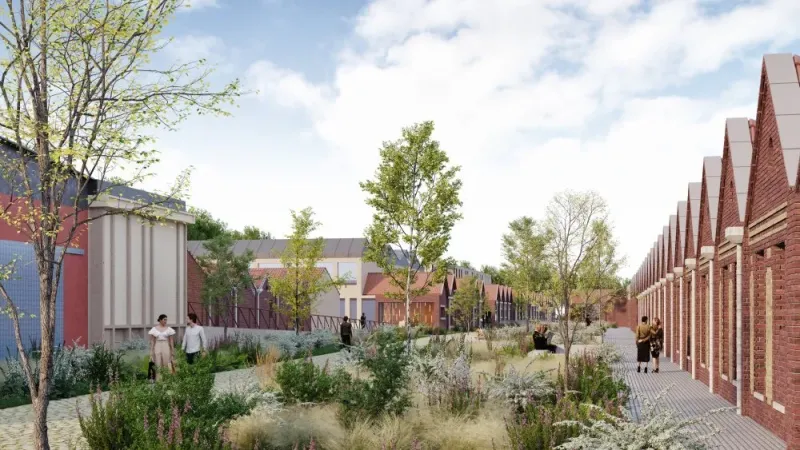Normandie is set to breathe new life into the abandoned Desgenétais factory in Bolbec with a €30 million transformation into a vibrant ecosystem dedicated to sustainable textiles. Starting in 2028, the seven-hectare red-brick site will unite heritage and innovation by hosting 30 to 40 SMEs, around 100 students, a business incubator, technical platforms, training organizations, housing, and a museum. Managed by the Caux Seine Agglo urban community with strong public and private backing, the project will revive one of the last icons of the region’s textile golden age while shaping the future of training, production, and innovation.
A new circular and sustainable model
From research and development to recycling, the “City of Tomorrow’s Textiles” aims to anticipate and accelerate the industry’s transition toward a circular, sustainable model.
Conceived as an innovation ecosystem, the project is designed to generate real momentum in training, production, and industrial renewal, while supporting new talent. By drawing on Bolbec’s rich textile heritage of the 18th and 19th centuries, it seeks to project forward—equipping the region with the tools to rebuild a competitive, future-facing industrial base.
France is already home to pioneering brands such as Coco&Rico, Le Slip Français, and Saint James, alongside Normandy’s internationally renowned fashion ecosystem with Hermès, LVMH, Chanel, and Anne Fontaine. Large-scale initiatives are also helping to anchor this shift: SNCF recently placed an order for workwear made from Normandy flax.
Among the project’s partners is Façons de faire, a professional network of 400 companies committed to reimagining textiles and championing local, natural, bio-based, and recycled resources.
A Cluster of 30–40 Textile Firms
To reindustrialise the region by reviving its historic textile base, the local authority is leveraging Normandy’s strengths: bast fibres such as hemp and flax (still largely exported to Asia), alongside bio-based and recycled fibres, supported by future site partners.
The site will host 30 to 40 SMEs, giving them access to competitively priced raw materials, advanced production tools, and a joint purchasing platform to secure access to public and private markets.
On the training side, the site expects to welcome around 100 students in vocational and technical tracks (CAP to BTS), 20 postgraduate students in textile and fibre design, and a range of continuing education participants.
Links to the region’s industrial past will be maintained through a new workshop-museum, bridging heritage and innovation.
The initiative aligns with wider regional strategies. The Regional Committee for the Circular Economy (CREC) — a joint State-Region body steering policy on circular economy — has proposed making textiles a priority area.
The choice reflects several drivers:
-
feedback from the NECI network (Normandy Circular Economy Network), which has flagged major challenges, in line with national trends;
-
overlaps with plastics, another CREC priority currently under review;
-
the economic importance of natural fibre production in Normandy, particularly flax, which accounts for 62% of France’s output (405,605 tonnes), but faces structural gaps in processing capacity.
As part of this effort, the CREC will hold a technical day on “Fibres and Textiles in Normandy for Ecological Transition” on 20 November 2025. In preparation, the OBDEC (Normandy Observatory of Waste, Resources, and the Circular Economy) is conducting a study of the regional textile sector. Preliminary findings confirm national analyses of weaknesses in the clothing, linen, and textile (TLC) value chain. Full results will be presented at the November event.
France’s Extended Producer Responsibility (EPR) scheme for textiles, household linen, and footwear (TLC), created in 2008, is under growing strain. Managed monopolistically by the eco-organization Refashion, the system collected only 36.4% of products placed on the market in 2023, while volumes surged to 3.5 billion items in 2024 (+11.8% since 2019, or 42 pieces per inhabitant). This growth is largely fueled by online fast-fashion sales (+29.9%), which generate vast flows of low-cost textiles.
Traditional social economy actors responsible for collection and sorting face worsening economic difficulties due to lower-quality donations and the diversion of higher-value items to resale platforms. At the same time, the sector’s historical dependence on exports has become problematic: markets such as Russia, Ukraine, and India have restricted imports, while African buyers now turn to cheaper Asian second-hand goods. This saturation leads to increasing diversion of TLC waste into municipal bins or illegal dumping, burdening local authorities.
Stakeholders have reacted strongly. In June 2024, the Environment Ministry formally demanded Refashion increase its financial contributions. A “Fast Fashion” bill was introduced in January 2024 and will be examined in late 2025. In protest, Le Relais, France’s leading collector, suspended voluntary drop-off collections in July 2025. The association Amorce has urged municipalities to bill Refashion directly for extra waste management costs.
To ease tensions, the government required Refashion to unlock €49 million in emergency aid for 2025 and announced a full overhaul of the EPR framework by 2026. Priorities include reducing exports, improving traceability, building domestic recycling capacity, and temporarily increasing energy recovery.
The article was prepared by an ECIV partner Région Normandie.


